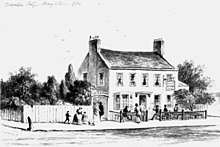Yorkshire Stingo
The Yorkshire Stingo was a public house in Marylebone in the 18th and 19th centuries, and served as a significant landmark just outside central London.[1]

Located on the south side of the Marylebone Road, it was a rural location when first built, before the construction of the New Road. An admittance charge was made, redeemable with the waiters, as a method of preventing those with no money from enjoying the facilities.
Its name comes from a fashionable slang word of the 18th century for strong or old ale.[1] The name possibly comes from the sharp, or "stinging" flavour of a well-matured beer.[2]
In 1786, the Committee for the Relief of the Black Poor used it as one of the centres for distributing alms.[3] A bowling green and pleasure gardens were added in the 18th century.
In 1829, it became one of the first terminuses for London buses. In 1836, an early music hall for vaudeville and burlesque, called the Apollo Saloon, was added, but by 1848 the gardens were closed. The public house was finally closed in 1964. The site has since been used for the County Court and a public baths.
Thomas Paine's cast iron bridge
During 1790 the Yorkshire Stingo was the temporary home of the second cast iron bridge ever built.[1] (The first was The Iron Bridge.) This was designed by Thomas Paine, better known as the author of the revolutionary best-seller Rights of Man. Paine had endeavoured to interest the authorities in Philadelphia and Paris in his design. He had gained a patent for this in 1788 and Walkers, who had an ironworks in Sheffield, agreed to construct it. Paine said of it that "Nothing in the world is as fine as my bridge, except a woman."[4]
The original design of 250 feet (76.2 m) – to span the Schuylkill River, Philadelphia – had been scaled down to 90 feet (27.4 m). Paine discussed the bridge in correspondence with Thomas Jefferson, Sir Joseph Banks, George Washington and Sir George Staunton, and entertained hopes that it might be the model for an iron bridge across the Thames as well as the Seine. Paine supervised both the work at the Walker factory, and the erection of the bridge in the grounds of the Yorkshire Stingo.[5] It weighed three tons and could bear a weight of six. Peter Whiteside, a Philadelphian merchant, was backing the project, but found himself in financial difficulties and asked Paine to return the money he had lent; in the end, the project had to be abandoned. Parts of it were then used in a bridge over the River Wear in Sunderland. William Yates, who had acted as Paine's foreman, went on to work on the Wear bridge and then Southwark Bridge, built by John Rennie. Paine later quipped that "the French revolution, and Mr Burke's attacks upon it, drew me off any pontifical works".
References
- Weinreb, Ben; Hibbert, Christopher (1993). The London Encyclopaedia (Rev. ed.). London: PaperMac. p. 1004. ISBN 0333576888. OCLC 28963301.
- "Webster's Revised Unabridged Dictionary (1913)". Retrieved 9 February 2015.
- The Yorkshire Stingo public house (National Archives) accessed 16 January 2008
- Unger, Harlow Giles (2019). Thomas Paine and the Clarion Call for American Independence. Hachette Books. ISBN 978-0-306-92194-0.
- The Commissioners of Patents (1868), "Introduction", Patents for inventions: Abridgments of specifications relating to Bridges, Viaducts and Aqueducts, A.D. 1750–1866, The Patent Office, p. xi